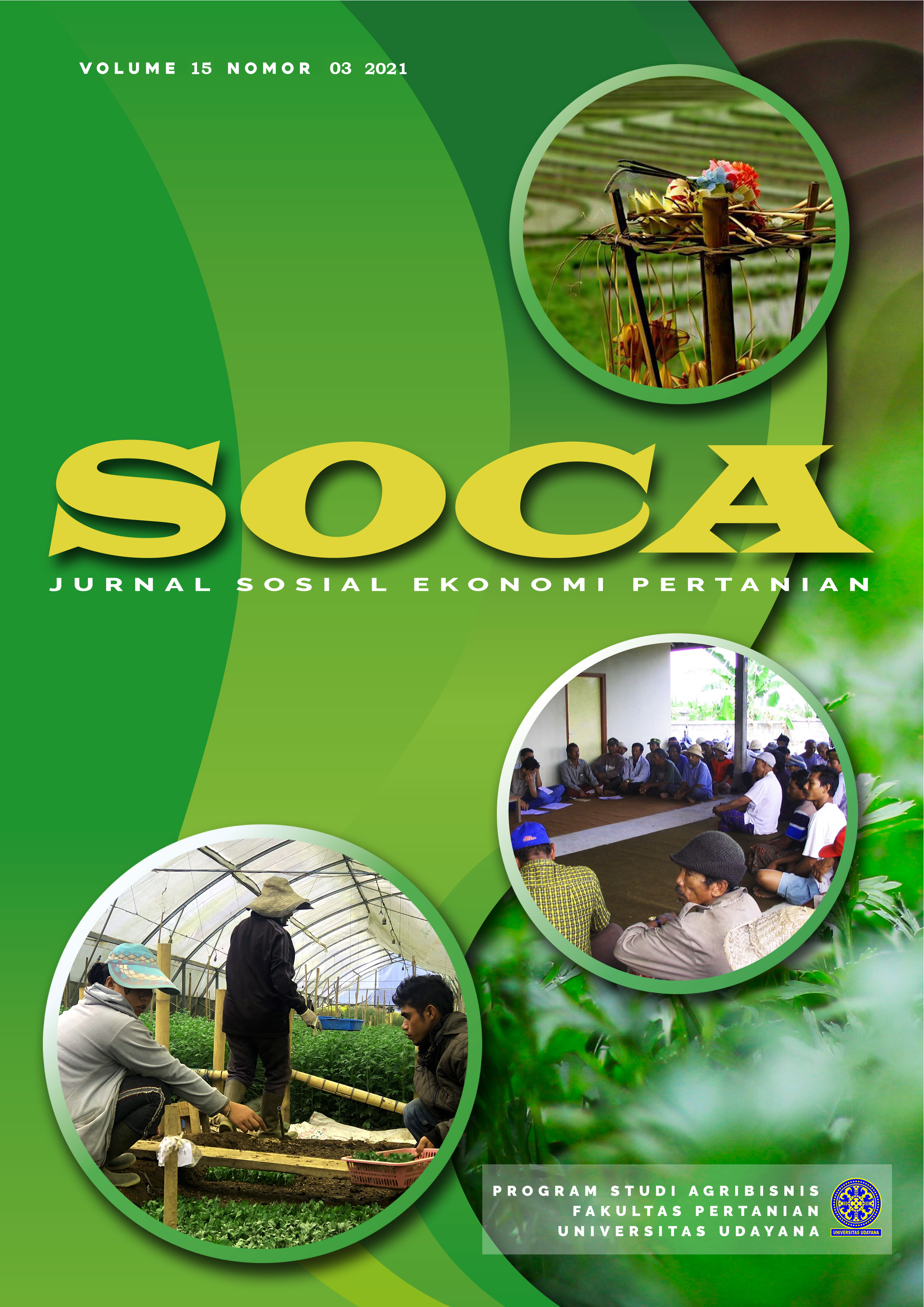The Sustainability Prospective of Irrigation System Management in Bali and Outside of Bali
Abstract
Effective and efficient water resources management is unquestionably required to meet the high demand of water to support rapid population growth and socio-economic expansion. The water supply availability is slowly decreased due to plantation land clearing, construction projects, and land-change activities in the watershed area. This study aimed to analyze the sustainability of irrigation management in Bali and outside of Bali (Bolaang Mongondow Regency, North Sulawesi). Primary and secondary data were employed in this study. In-depth interview and focus group discussion sessions conducted to collect the primary data. The literature review technique applied to gather secondary data to support the study result and discussion. We recruited the committee of subak, farmers, and stakeholders or policymakers from the Local Board of Agriculture and Public Works and Public Housing (sub-irrigation division) to participate in this study. Multi-Dimensional Scaling method employed to analyze the study data. Results revealed that the sustainability prospective of the irrigation system management in Mongondow was relatively weak, especially on the physical-ecological, infrastructure-technology, and policy-institutional dimensions. However, we noticed that the economy and social dimension of the watershed area was relatively sustainable. Contrary situations were found on Saba Watershed in Buleleng Regency, Bali Province. We found that the sustainability prospective on the physical-ecological and infrastructure-technology dimension was relatively weak. But the dimension of the economy, socio-cultural, and policy-institutional was adequately sustainable.
Downloads
References
Badan Pusat Statistik Sulawesi Utara. (2019). Provinsi Sulawesi Utara Dalam Angka 2018 (Bidang Integrasi Pengolahan dan Diseminasi Statistik (ed.)). CV. Bahu Bahtera Indah.
Budiasa, I. W., Setiawan, B. I., Kato, H., Sekino, N., & Kubota, J. (2015). The Role of The Subak System and Tourism on Land Use Changes within The Saba Watershed, Northern Bali, Indonesia. Journal of the International Society for Southeast Asian Agricultural Sciences, 21(2), 31–47.
Dale, V. H., & Beyeler, S. C. (2001). Challenges in the development and use of ecological indicators. Ecological Indicators, 1(1), 3–10. https://doi.org/10.1016/S1470-160X(01)00003-6
Fauzi, A., & Anna, S. (2005). Pemodelan Sumber Daya Perikanan dan Kelautan Untuk Analisis Kebijakan. PT. Gramedia Pustaka Utama.
Hariawan, S. F. X., Rumambi, D. P., Pakasi, S. E., Southeast, S., Regency, M., District, R., & Minahasa, S. (2020). Pemetaan Kondisi Fisik Jaringan Irigasi Desa Rasi Raya Kecamatan Ratahan Kabupaten Minahasa Tenggara Berbasis Sistem Informasi Geografis. Cocos, 3(3).
Ineke, V. A., Tanudjaja, L., & Jeffry, S. F. S. (2017). Analisis Neraca Air Sungai Sangkub Di Titik Bendung Sangkub Kabupaten Bolaang Mongondow Utara. Jurnal Sipil Statik, 5(8), 123–132.
Kalesaran, L. H., Husain, J. ., & Polii, B. V. J. (2016). Evaluasi Sistem Pengelolaan Daerah Irigasi Di Provinsi Sulawesi Utara. AGRI-SOSIOEKONOMI, 12(1), 1. https://doi.org/10.35791/agrsosek.12.1.2016.11076
Lepa, O., & Rachman, I. (2019). Peran Pemerintah Daerah Kabupaten Bolaang Mongondow dalam Pembangunan Pertanian (Studi di Kecamatan Passi Timur). Jurnal Eksekutif, 3(3), 1–10.
Meinzen-Dick, R. (2014). Property rights and sustainable irrigation: A developing country perspective. Agricultural Water Management, 145, 23–31. https://doi.org/10.1016/j.agwat.2014.03.017
Prodanovic, P., & Simonovic, S. P. (2010). An Operational Model for Support of Integrated Watershed Management. Water Resources Management, 24(6), 1161–1194. https://doi.org/10.1007/s11269-009-9490-6
Rachman, B., & Kariyasa, K. (2003). Dinamika Kelembagaan Pengelolaan Air Irigasi. Soca: Jurnal Sosial Ekonomi Pertanian, 3(1), 1–15. https://ojs.unud.ac.id/index.php/soca/article/view/4014
Rumambi, D. P., & Ludong, D. P. . (2017). Kajian Tentang Pemberian Air Irigasi Pada Pengolahan Lahan Padi Sawah Dengan Menggunakan ALSINTAN (Transplanter Dan Combine Harvester) Di Desa Popontolen Kabupaten Minahasa Selatan.
Scott Jansing, Mahichi, & Dasanayake. (2020). Sustainable Irrigation Management in Paddy Rice Agriculture: A Comparative Case Study of Karangasem Indonesia and Kunisaki Japan. Sustainability, 12(3), 1180. https://doi.org/10.3390/su12031180
Setiawan, B. I., Sutoyo, Budiasa, I. W., Kato, H., & Kubota, J. (2015). Seasonal Variability of Rainfall in Saba Watershed of Bali Island. Proceeding of the Fourth International Workshop on CAAM‐GRENE.
Soegoto, A. S., & Sumarauw, J. S. B. (2014). Analisis Manajemen Usaha Petani Dan Pertanian Di Kawasan Agropolitan Dumoga Untuk Menopang Ketahanan Pangan Nasional. Jurnal EMBA : Jurnal Riset Ekonomi, Manajemen, Bisnis Dan Akuntansi, 2(4), 223–245. https://ejournal.unsrat.ac.id/index.php/emba/article/view/6253
Soetopo, A. A., Wilar, D., & Manoppo, F. J. (2017). Pemodelan Pengelolaan Risiko Proyek Pembangunan Jaringan Irigasi Sangkub Kiri Kabupaten Bolaang Mongondow Utara Mahasiswa Program studi Teknik Sipil Pasca Sarjana Unsrat TINJAUAN PUSTAKA Risiko merupakan suatu keadaan yang terdapat kemungkinan yang merugi. Jurnal Ilmiah Media Engineering, 7(3), 818–826.
Tunggali, L. ., Rotinsulu, W. ., & Tamod, Z. . (2016). Kajian Lingkungan Hidup Strategis Rencana Tata Ruang Wilayah Kawasan Peruntukan Pertambangan Di Kabupaten Bolaang Mongondow. AGRI-SOSIOEKONOMI, 12(3A), 179. https://doi.org/10.35791/agrsosek.12.3A.2016.14389
Yusuf, H., Wantasen, S., & Lumingkewas, A. M. W. (2018). Kajian Kualitas Air Sungai Bening Sebagai Sumber Air Irigasi Persawahan Di Desa Mopuya Selatan II Kecamatan Dumoga Utara Kabupaten Bolaang Mongondowcocos. Cocos, 1(3), 23–34.













